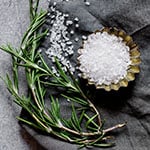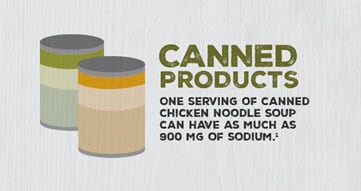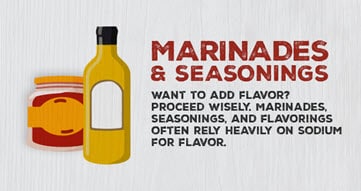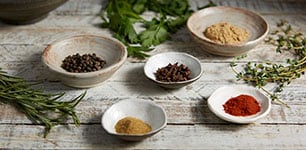 May is National Blood Pressure Awareness Month. What does that have to do with sodium? More than you think. That’s because consuming too much sodium can lead to high blood pressure, which, if uncontrolled, can lead to heart disease, stroke, and blindness.1
May is National Blood Pressure Awareness Month. What does that have to do with sodium? More than you think. That’s because consuming too much sodium can lead to high blood pressure, which, if uncontrolled, can lead to heart disease, stroke, and blindness.1
12015 – 2020 Dietary Guidelines for Americans
So how much is too much?
Currently, Americans consume an average of 3440 mg of sodium per day. But according to the 2015 – 2020 Dietary Guidelines for Americans, most adults and children age 14 and older should limit sodium intake to no more than 2300 mg per day.2
2“Sodium in Your Diet: Use the Nutrition Facts Label and Reduce Your Intake.” FDA.gov. June 2, 2016.
Where does sodium hide?
Reducing your sodium intake takes more than simply passing on the salt. In fact, more than 75% of the sodium in the average American diet comes from salt in processed foods.3 This means that you could be eating too much sodium without even knowing it.
3Get the Facts: Sodium and the Dietary Guidelines." CDC.gov. April 2016.
3 High-Sodium Foods That May Surprise You
Sodium can be pretty sneaky sometimes. It can hide in the foods that you'd least expect. But luckily, you always have a secret weapon at your disposal—the label.
Generally, a product that is low-sodium is defined as containing 140 mg or less of sodium per serving. But some foods can contain as much as 1,000 mg of sodium per serving, if not more. And the foods that are high in sodium may surprise you.
Here's a list of three foods that can be high in sodium. When buying them, look for an option with less sodium if possible.
1. Canned Products

When it’s canned, it’s worth a second look. For example, one serving of canned chicken noodle soup can have as much as 900 milligrams of sodium.1
Delicious Tip: When it comes to canned soups, look for reduced sodium options, or try to make it at home. Rinse canned veggies before preparing, which will reduce the sodium.
2. Marinades, Seasonings, and Flavorings

Want to add flavor? Proceed wisely. Marinades, seasonings, and flavorings often rely heavily on sodium for flavor. For example, 2 teaspoons of packaged taco seasoning can have over 400 mg of sodium.1
Delicious Tip: Reach for vinegar and lemon juice for flavor. Or make your own marinades and seasoning blends using herbs and spices at home so you can eliminate or control the salt in them.
3. Meat and Poultry

While there’s a small amount of sodium in fresh and frozen meat, sodium is often added in processing. For example, chicken is often enhanced with a solution, which can make it extremely high in sodium.
Delicious Tip: Look for fresh or frozen meat that hasn't been injected with a sodium solution. When buying meat and poultry, always check ingredients on the label and make sure you avoid products that have ingredients like "broth," "saline," or "sodium solution." And with processed meat, try to find options that are lower in sodium.2
1"The Salty 6." American Heart Association. December 2016.
2"How to Reduce Sodium." American Heart Association. April 19, 2017.

 You are about to leave publix.com and enter the Instacart site that they operate and control. Publix’s delivery and curbside pickup item prices are higher than item prices in physical store locations. Prices are based on data collected in store and are subject to delays and errors. Fees, tips & taxes may apply. Subject to terms & availability. Publix Liquors orders cannot be combined with grocery delivery. Drink Responsibly. Be 21. For prescription delivery, log in to your pharmacy account by using the Publix Pharmacy app or visiting
You are about to leave publix.com and enter the Instacart site that they operate and control. Publix’s delivery and curbside pickup item prices are higher than item prices in physical store locations. Prices are based on data collected in store and are subject to delays and errors. Fees, tips & taxes may apply. Subject to terms & availability. Publix Liquors orders cannot be combined with grocery delivery. Drink Responsibly. Be 21. For prescription delivery, log in to your pharmacy account by using the Publix Pharmacy app or visiting 

